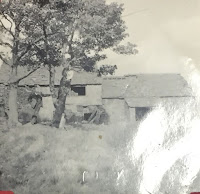Of the many reasons to accept the offer to teach Sylvia Plath at the Sylvia Plath and Ted Hughes Summer School at Lumb Bank in Heptonstall, Yorkshire, one of the perks of the offer was the midweek day off from teaching in which the group journeyed to Haworth to visit the Brontë Parsonage and make the walk to Top Withens, the house that is rumored to have inspired Emily Brontë's beautiful, haunting, and perfect novel Wuthering Heights, have a pint at the Black Bull and walk around the village.
The program of teaching with Heather Clark at Lumb Bank was a good one. I had the morning class from 9:30 to 11 am. Heather taught after a 30 minutes break from 11:30 to 1. Then lunch, followed by a varying schedule in the afternoon that saw some visitors (Steve Ely, Pascale Petit, and Carrie Smith) and some downtime. My class was upstairs in the barn and we focused on Plath's novel The Bell Jar. I overprepared, in that I did not get to cover everything that I planned. And this included kind of calling an audible on the last day so I am sorry that everything that I intended to "teach" did not actually get taught. There was enough downtime so that nothing ever felt rushed or overwhelming; the week went by at a truly measured pace but in some ways it honestly feels like it never happened. I blame the real world for that!
The students were wonderful. Attentive, social, inquisitive, and put me at ease with their receptiveness. The staff at Lumb Bank, too, could not have been kinder or more accommodating to all our needs and wants and persnicketiness.
Getting to visit Sylvia Plath's grave at least once per day was a treat. Exploring the area on foot walking or running, too, was delicious. The views in any direction at any time of day were breathtaking.
Plath set several poems in Yorkshire as well as a few prose works and she sent letters and wrote in her journal while there, too. In Appendix 10 of her journals, which Plath used from roughly 26 June 1956 to 6 March 1961, Plath writes about a visit to Haworth and the Brontë Parsonage. The time period for this is late August 1956 to September 1956. But surely we can be more specific for this visit to Haworth. In a previous post where I dated some of Plath's undated journal entries, I assigned this entry to 24 September 1956.
Plath wrote about her first visit to Haworth in her pocket calendar (held by Lilly Library) on 31 August 1956. She drove with her husband and uncle-in-law, had a sandwich picnic amongst the heather, took the "long hike" to Wuthering Heights, commented on the sheep, started to draw, and then they had tea in Haworth. On 24 September, she was back in Haworth with her husband, her friend from Smith Elinor Klein, and someone called John. In her calendar here she comments on visiting the Parsonage with its "minute books & watercolors". Again they took the hike past the waterfall to Top Withens, where they had another picnic and she drew in the wind. Five years later, when composing her poem "Wuthering Heights" she recalled this notable landscape and its wind when the speaker of the poem says, "There is no life higher than the grasstops / Or the hearts of sheep, and the wind / Pours by like destiny, bending / Everything in one direction." (While we were there I took a brief video capturing the wind bending the grass while one of the students, Whit, read the poem.)
Plath writes about the Parsonage on pages 580-2 in her published journals. So check them out as you view the following photographs.
 |
| Sofa on which Emily Brontë died |
 |
| Emily Brontë's rosewood writing desk, etc. |
 |
| Apostle cupboard (see Jane Eyre) |
Previously, I did the walk to Withens in September 1996 on a memorably drenching rainy day. I tried to do it again the following year but for various reasons I failed. It had been a dream in my previous visit to Yorkshire to make the hike once more but traveling primarily in winter did not lend itself to a six or so mile excursion. The weather Tuesday in Lumb Bank was atrocious but there was no vestige of it on Wednesday morning and the day was, simply put, perfect. Here are some photographs from the hike.
 |
| The graveyard in Haworth by the Parsonage. See SP's "November Graveyard, Haworth." |
 |
| Getting there... |
 |
| Above the Heights |
Whit, myself, and two others all climbed the tree next to the house just as Plath did.
All links accessed 19 August 2023.








